Strategic Analysis: Applying Porter's 5 Forces to Starbucks Corp.
VerifiedAdded on 2023/06/09
|6
|853
|480
Report
AI Summary
This report provides a strategic analysis of Starbucks using Porter's Five Forces model to identify its competitive advantages. It assesses the threat of new entrants, the threat of substitutes, the bargaining power of buyers and suppliers, and the intensity of competitive rivalry within the coffee and beverage industry. The analysis reveals that while Starbucks faces high competitive rivalry and threats from substitutes, its brand loyalty, quality products, and ethical sourcing policies contribute to its strong market position. The report concludes that Starbucks' core strategies and competencies have enabled it to establish a significant global presence and maintain a competitive edge despite industry challenges. Desklib provides a platform to access this document and many other solved assignments.
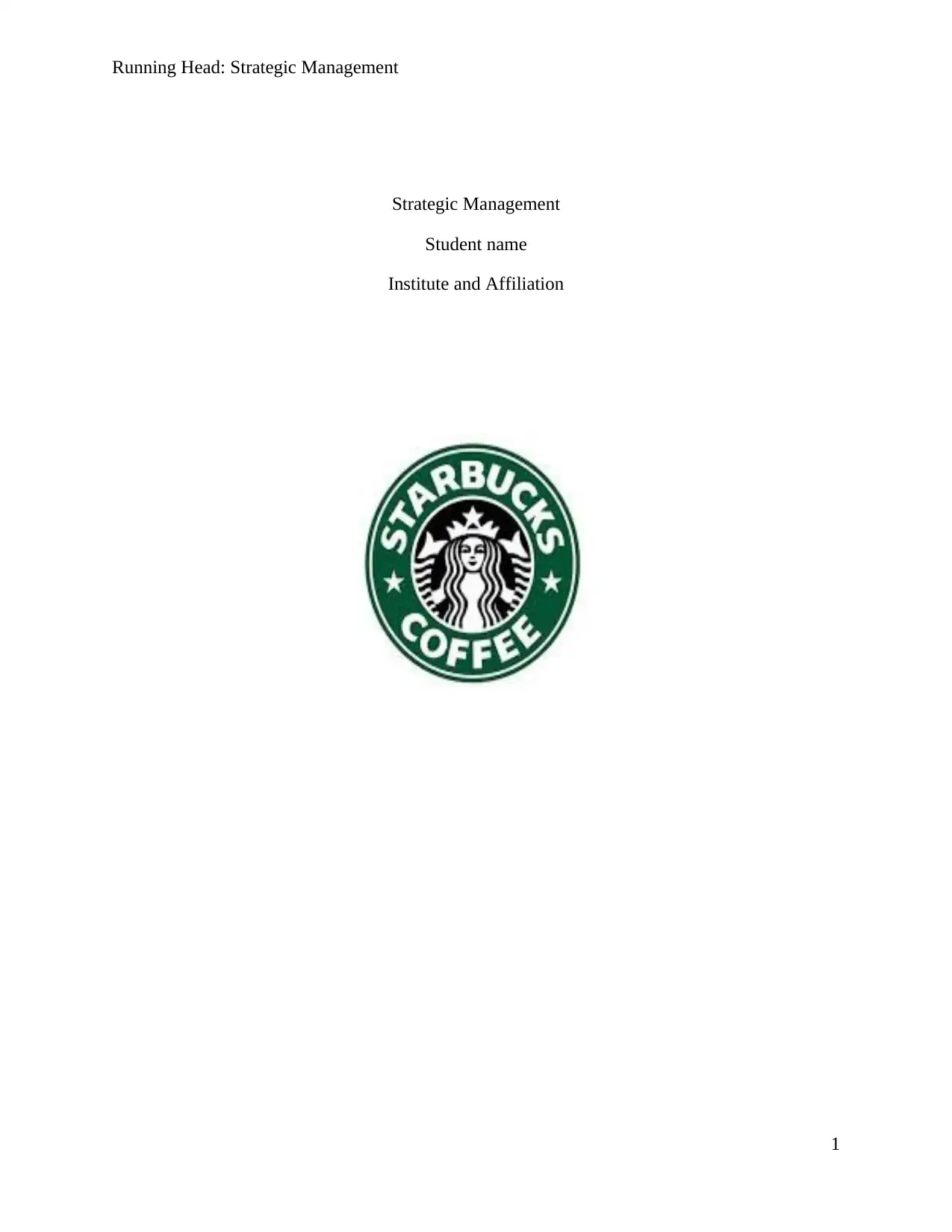
Running Head: Strategic Management
Strategic Management
Student name
Institute and Affiliation
1
Strategic Management
Student name
Institute and Affiliation
1
Paraphrase This Document
Need a fresh take? Get an instant paraphrase of this document with our AI Paraphraser
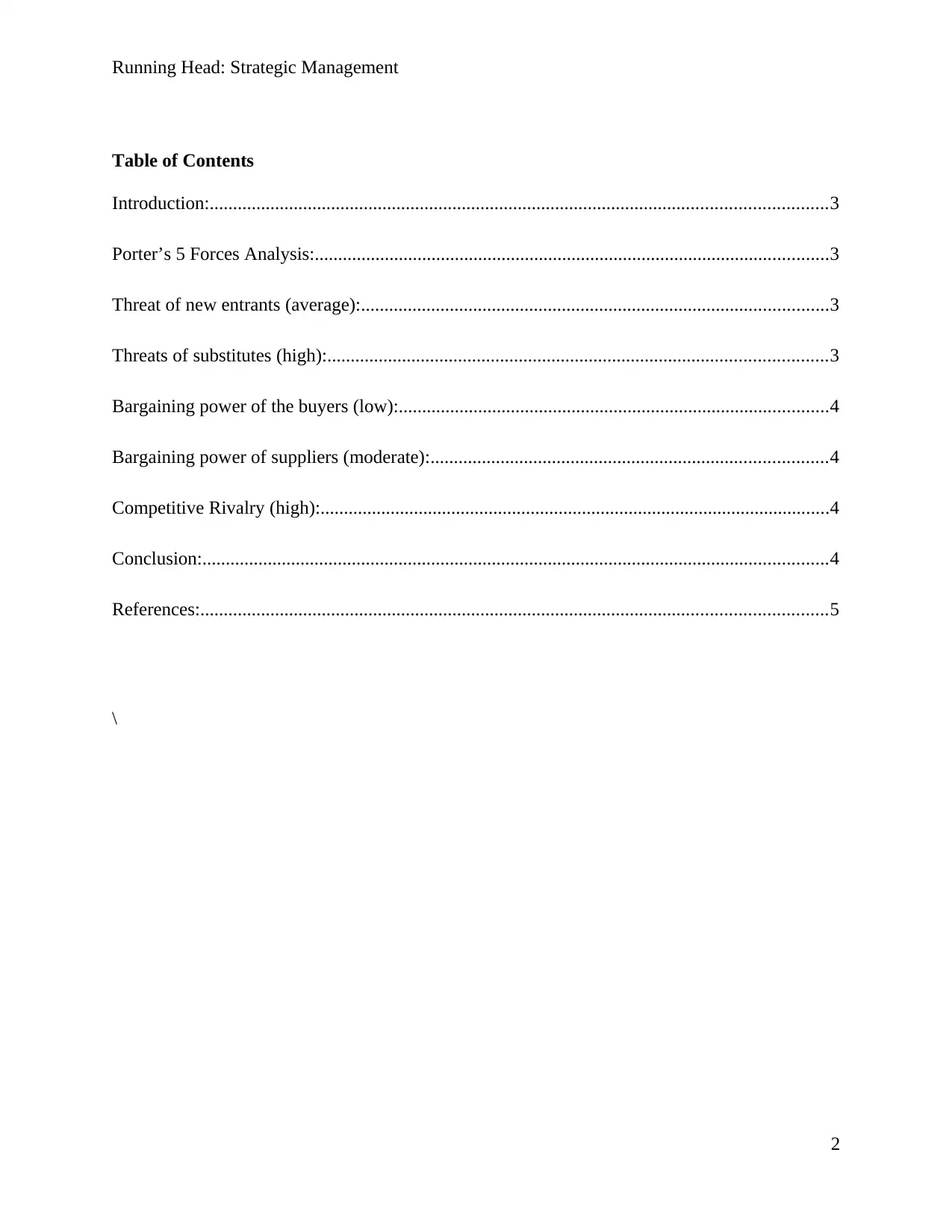
Running Head: Strategic Management
Table of Contents
Introduction:....................................................................................................................................3
Porter’s 5 Forces Analysis:..............................................................................................................3
Threat of new entrants (average):....................................................................................................3
Threats of substitutes (high):...........................................................................................................3
Bargaining power of the buyers (low):............................................................................................4
Bargaining power of suppliers (moderate):.....................................................................................4
Competitive Rivalry (high):.............................................................................................................4
Conclusion:......................................................................................................................................4
References:......................................................................................................................................5
\
2
Table of Contents
Introduction:....................................................................................................................................3
Porter’s 5 Forces Analysis:..............................................................................................................3
Threat of new entrants (average):....................................................................................................3
Threats of substitutes (high):...........................................................................................................3
Bargaining power of the buyers (low):............................................................................................4
Bargaining power of suppliers (moderate):.....................................................................................4
Competitive Rivalry (high):.............................................................................................................4
Conclusion:......................................................................................................................................4
References:......................................................................................................................................5
\
2
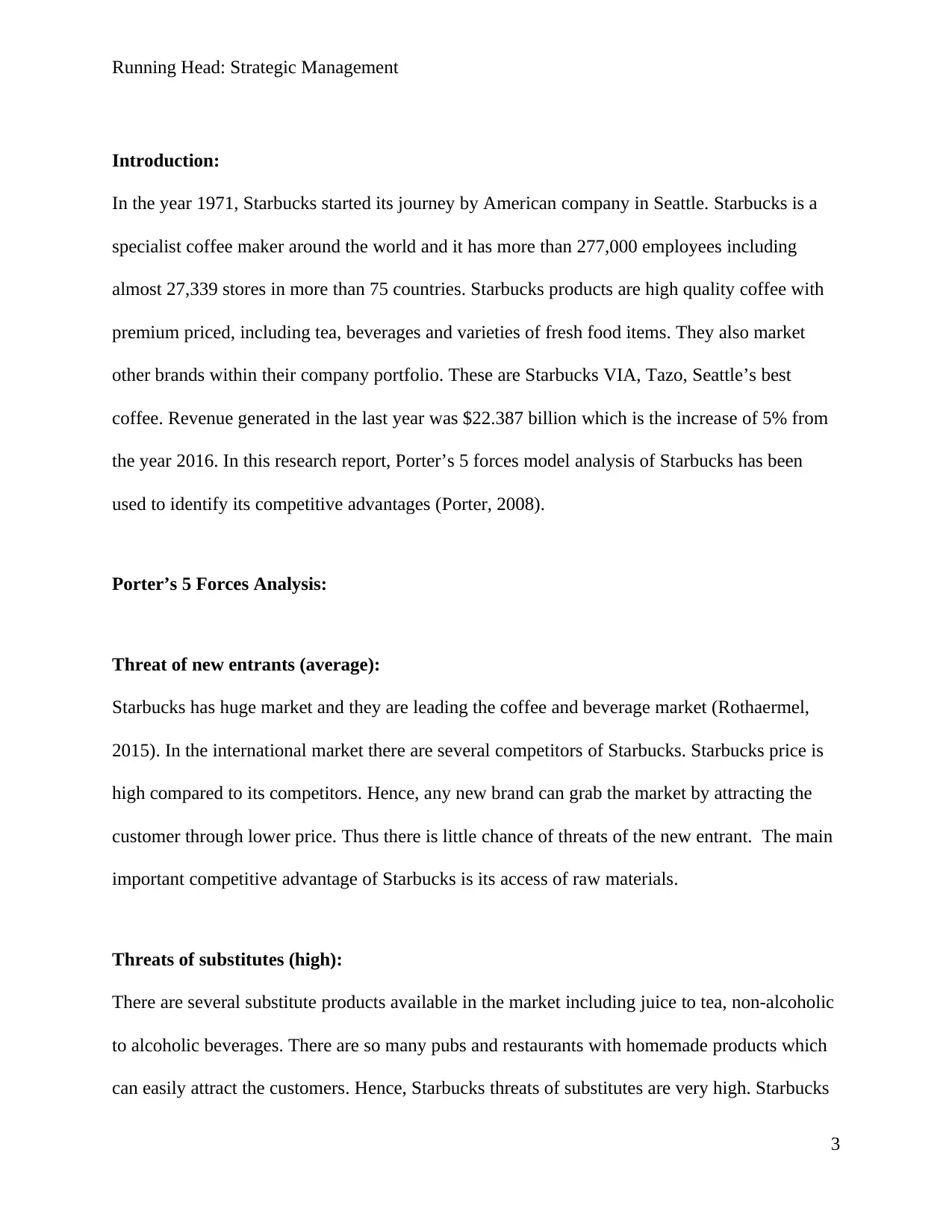
Running Head: Strategic Management
Introduction:
In the year 1971, Starbucks started its journey by American company in Seattle. Starbucks is a
specialist coffee maker around the world and it has more than 277,000 employees including
almost 27,339 stores in more than 75 countries. Starbucks products are high quality coffee with
premium priced, including tea, beverages and varieties of fresh food items. They also market
other brands within their company portfolio. These are Starbucks VIA, Tazo, Seattle’s best
coffee. Revenue generated in the last year was $22.387 billion which is the increase of 5% from
the year 2016. In this research report, Porter’s 5 forces model analysis of Starbucks has been
used to identify its competitive advantages (Porter, 2008).
Porter’s 5 Forces Analysis:
Threat of new entrants (average):
Starbucks has huge market and they are leading the coffee and beverage market (Rothaermel,
2015). In the international market there are several competitors of Starbucks. Starbucks price is
high compared to its competitors. Hence, any new brand can grab the market by attracting the
customer through lower price. Thus there is little chance of threats of the new entrant. The main
important competitive advantage of Starbucks is its access of raw materials.
Threats of substitutes (high):
There are several substitute products available in the market including juice to tea, non-alcoholic
to alcoholic beverages. There are so many pubs and restaurants with homemade products which
can easily attract the customers. Hence, Starbucks threats of substitutes are very high. Starbucks
3
Introduction:
In the year 1971, Starbucks started its journey by American company in Seattle. Starbucks is a
specialist coffee maker around the world and it has more than 277,000 employees including
almost 27,339 stores in more than 75 countries. Starbucks products are high quality coffee with
premium priced, including tea, beverages and varieties of fresh food items. They also market
other brands within their company portfolio. These are Starbucks VIA, Tazo, Seattle’s best
coffee. Revenue generated in the last year was $22.387 billion which is the increase of 5% from
the year 2016. In this research report, Porter’s 5 forces model analysis of Starbucks has been
used to identify its competitive advantages (Porter, 2008).
Porter’s 5 Forces Analysis:
Threat of new entrants (average):
Starbucks has huge market and they are leading the coffee and beverage market (Rothaermel,
2015). In the international market there are several competitors of Starbucks. Starbucks price is
high compared to its competitors. Hence, any new brand can grab the market by attracting the
customer through lower price. Thus there is little chance of threats of the new entrant. The main
important competitive advantage of Starbucks is its access of raw materials.
Threats of substitutes (high):
There are several substitute products available in the market including juice to tea, non-alcoholic
to alcoholic beverages. There are so many pubs and restaurants with homemade products which
can easily attract the customers. Hence, Starbucks threats of substitutes are very high. Starbucks
3
⊘ This is a preview!⊘
Do you want full access?
Subscribe today to unlock all pages.

Trusted by 1+ million students worldwide
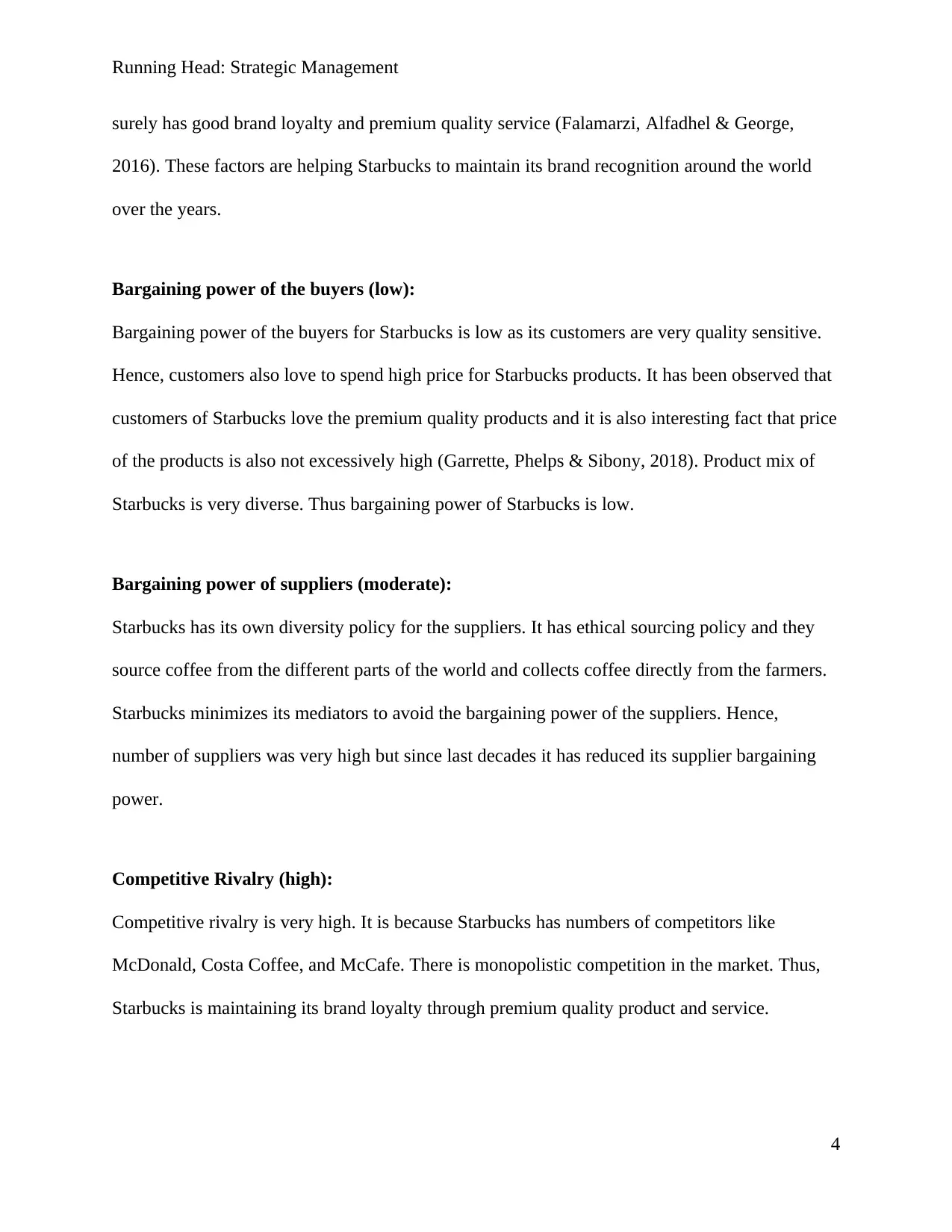
Running Head: Strategic Management
surely has good brand loyalty and premium quality service (Falamarzi, Alfadhel & George,
2016). These factors are helping Starbucks to maintain its brand recognition around the world
over the years.
Bargaining power of the buyers (low):
Bargaining power of the buyers for Starbucks is low as its customers are very quality sensitive.
Hence, customers also love to spend high price for Starbucks products. It has been observed that
customers of Starbucks love the premium quality products and it is also interesting fact that price
of the products is also not excessively high (Garrette, Phelps & Sibony, 2018). Product mix of
Starbucks is very diverse. Thus bargaining power of Starbucks is low.
Bargaining power of suppliers (moderate):
Starbucks has its own diversity policy for the suppliers. It has ethical sourcing policy and they
source coffee from the different parts of the world and collects coffee directly from the farmers.
Starbucks minimizes its mediators to avoid the bargaining power of the suppliers. Hence,
number of suppliers was very high but since last decades it has reduced its supplier bargaining
power.
Competitive Rivalry (high):
Competitive rivalry is very high. It is because Starbucks has numbers of competitors like
McDonald, Costa Coffee, and McCafe. There is monopolistic competition in the market. Thus,
Starbucks is maintaining its brand loyalty through premium quality product and service.
4
surely has good brand loyalty and premium quality service (Falamarzi, Alfadhel & George,
2016). These factors are helping Starbucks to maintain its brand recognition around the world
over the years.
Bargaining power of the buyers (low):
Bargaining power of the buyers for Starbucks is low as its customers are very quality sensitive.
Hence, customers also love to spend high price for Starbucks products. It has been observed that
customers of Starbucks love the premium quality products and it is also interesting fact that price
of the products is also not excessively high (Garrette, Phelps & Sibony, 2018). Product mix of
Starbucks is very diverse. Thus bargaining power of Starbucks is low.
Bargaining power of suppliers (moderate):
Starbucks has its own diversity policy for the suppliers. It has ethical sourcing policy and they
source coffee from the different parts of the world and collects coffee directly from the farmers.
Starbucks minimizes its mediators to avoid the bargaining power of the suppliers. Hence,
number of suppliers was very high but since last decades it has reduced its supplier bargaining
power.
Competitive Rivalry (high):
Competitive rivalry is very high. It is because Starbucks has numbers of competitors like
McDonald, Costa Coffee, and McCafe. There is monopolistic competition in the market. Thus,
Starbucks is maintaining its brand loyalty through premium quality product and service.
4
Paraphrase This Document
Need a fresh take? Get an instant paraphrase of this document with our AI Paraphraser
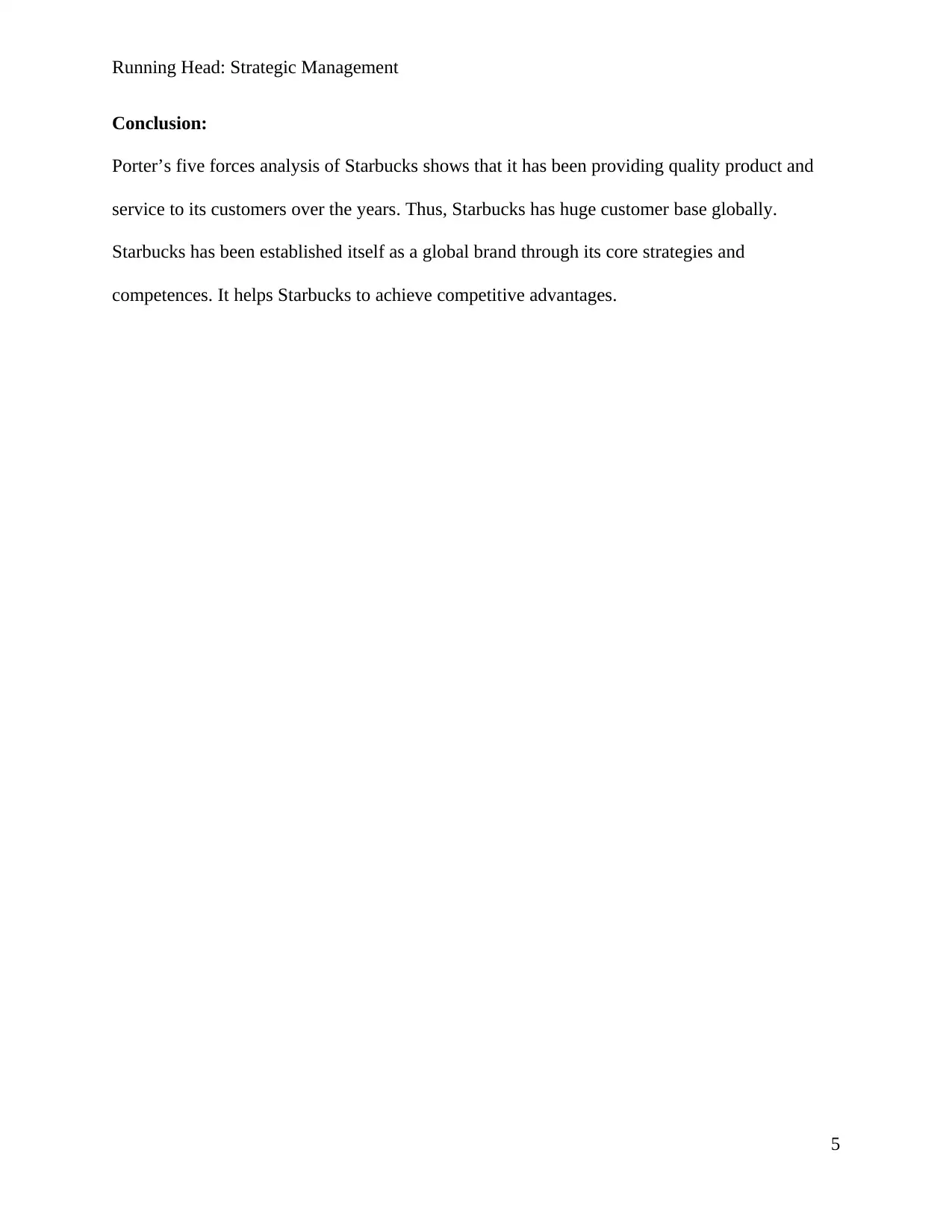
Running Head: Strategic Management
Conclusion:
Porter’s five forces analysis of Starbucks shows that it has been providing quality product and
service to its customers over the years. Thus, Starbucks has huge customer base globally.
Starbucks has been established itself as a global brand through its core strategies and
competences. It helps Starbucks to achieve competitive advantages.
5
Conclusion:
Porter’s five forces analysis of Starbucks shows that it has been providing quality product and
service to its customers over the years. Thus, Starbucks has huge customer base globally.
Starbucks has been established itself as a global brand through its core strategies and
competences. It helps Starbucks to achieve competitive advantages.
5
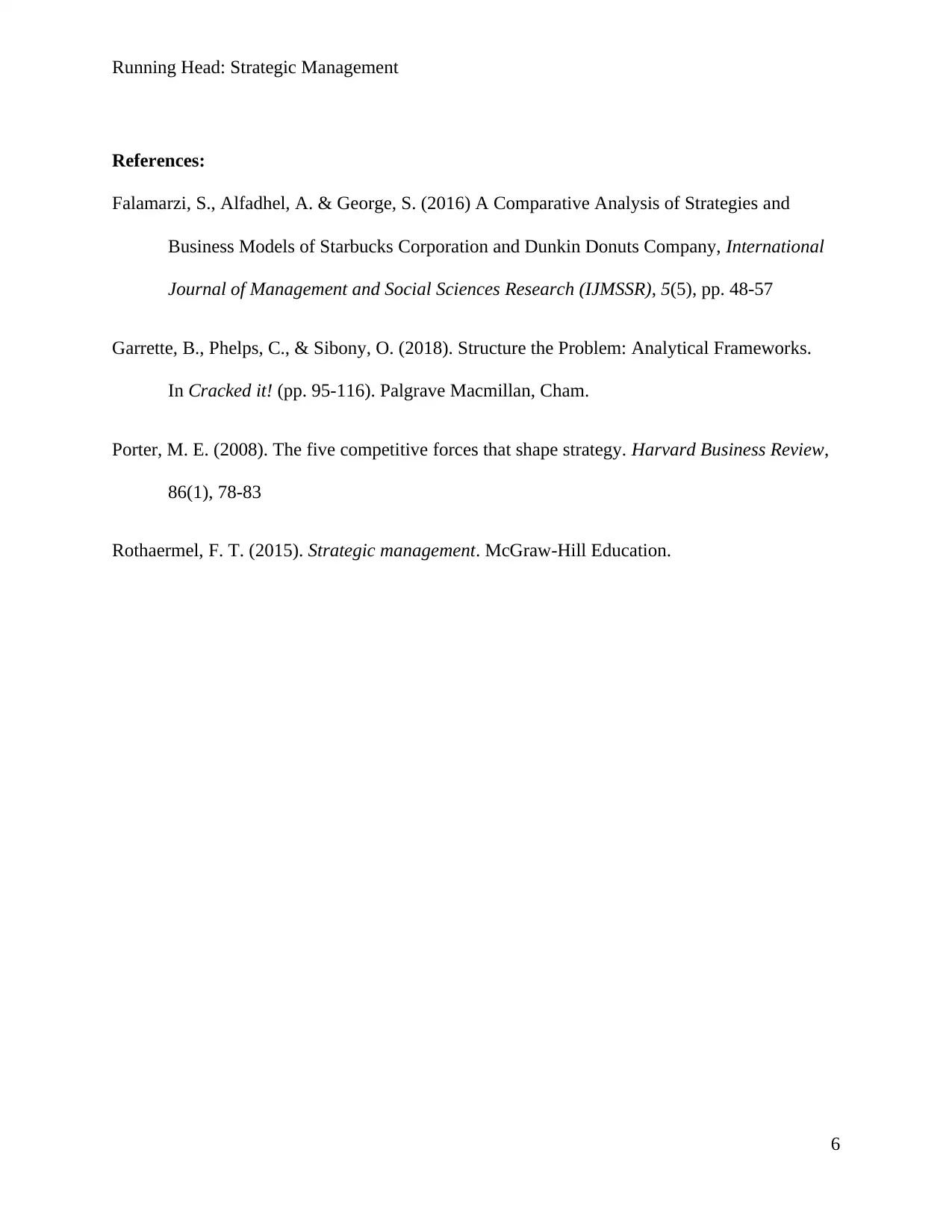
Running Head: Strategic Management
References:
Falamarzi, S., Alfadhel, A. & George, S. (2016) A Comparative Analysis of Strategies and
Business Models of Starbucks Corporation and Dunkin Donuts Company, International
Journal of Management and Social Sciences Research (IJMSSR), 5(5), pp. 48-57
Garrette, B., Phelps, C., & Sibony, O. (2018). Structure the Problem: Analytical Frameworks.
In Cracked it! (pp. 95-116). Palgrave Macmillan, Cham.
Porter, M. E. (2008). The five competitive forces that shape strategy. Harvard Business Review,
86(1), 78-83
Rothaermel, F. T. (2015). Strategic management. McGraw-Hill Education.
6
References:
Falamarzi, S., Alfadhel, A. & George, S. (2016) A Comparative Analysis of Strategies and
Business Models of Starbucks Corporation and Dunkin Donuts Company, International
Journal of Management and Social Sciences Research (IJMSSR), 5(5), pp. 48-57
Garrette, B., Phelps, C., & Sibony, O. (2018). Structure the Problem: Analytical Frameworks.
In Cracked it! (pp. 95-116). Palgrave Macmillan, Cham.
Porter, M. E. (2008). The five competitive forces that shape strategy. Harvard Business Review,
86(1), 78-83
Rothaermel, F. T. (2015). Strategic management. McGraw-Hill Education.
6
⊘ This is a preview!⊘
Do you want full access?
Subscribe today to unlock all pages.

Trusted by 1+ million students worldwide
1 out of 6
Related Documents
Your All-in-One AI-Powered Toolkit for Academic Success.
+13062052269
info@desklib.com
Available 24*7 on WhatsApp / Email
![[object Object]](/_next/static/media/star-bottom.7253800d.svg)
Unlock your academic potential
Copyright © 2020–2025 A2Z Services. All Rights Reserved. Developed and managed by ZUCOL.





